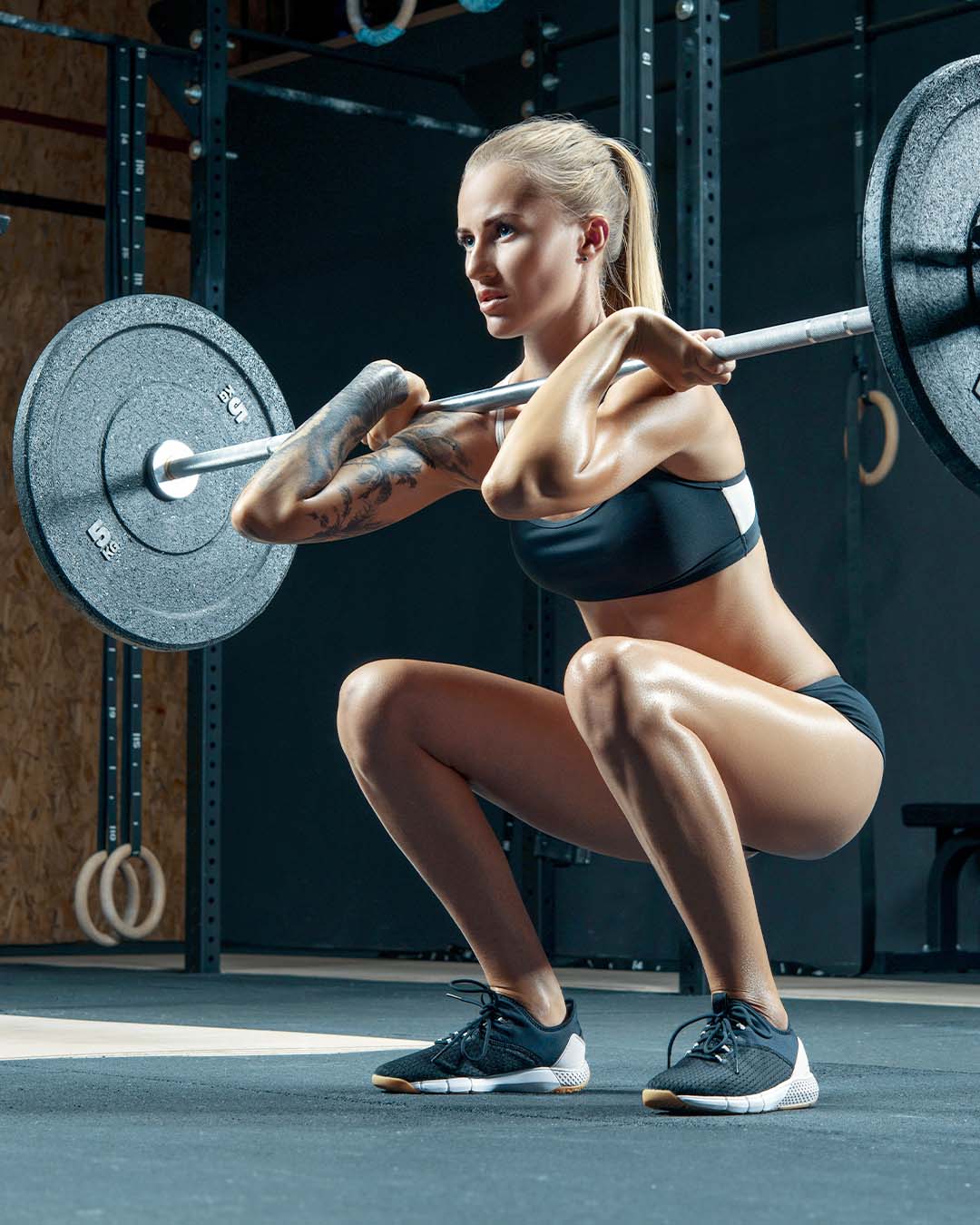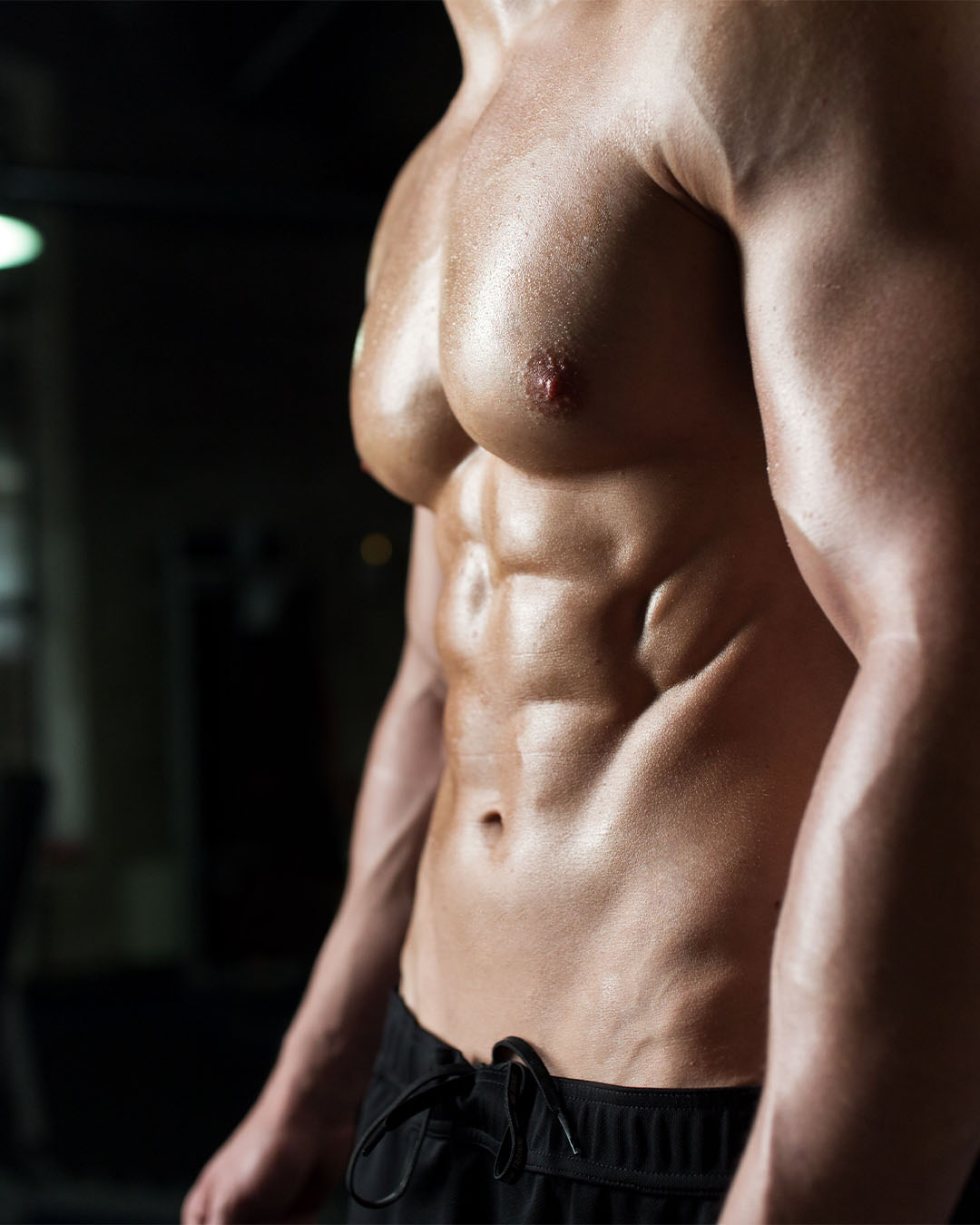Front Squats
Have you ever wondered why athletes do front squats at the gym? There are some benefits to the front squats like quad activation, a strong core, and less spinal compression. Keep reading to learn more benefits, tips, and techniques of the front squat.
Proper Form
First and foremost, the proper technique is important. Anytime you load your back with weights, you need to keep a neutral spine. If you remember to keep you chest lifted, you will almost always have a perfect posture like our model below.

Furthermore, hold the bar on your upper chest or on your front deltoids. Place your feet about shoulder width apart. With your chest out, inhale and squat down as if you were sitting on a chair. Return to the starting position as you exhale.
Your Grip
There are two main grips for the front squats but both require you to lay the bar on your anterior deltoids. The first option, and probably the most popular, would be to flip your wrists and use your hands, fingers, and deltoids to hold the bar in place (pictured above).
If your wrist flexors are not flexible enough for the first option, then you can cross your arms and hold the bar in place with your fingers. Choose the option which is most comfortable to you but no matter the option, you'll have to keep your elbows high to keep the bar in place.
Quad Activation
When performing the front squat, you recruit all the same muscles as you would normally recruit during a back squat. Except, it is possible that the front squat recruits more quad muscles than the back squat. This may be due to a shift in the center of gravity. A study by Yavuz et al. (2015) showed more knee extensor activation in the front squat, than the back squat. So, if you're looking for more quad activation, give front squats a try.
Want to learn more about exercise science and sports nutrition? Click on the image below to get more info on all of our classes.

Spinal Compression
Recruiting more quads is a great reason to include front squats in your exercise routine. But another reason to include front squats is reduced risk of injury to your low back. Yavuz et al. (2015) showed greater trunk flexion in the back squat, than the front squat. This means, if you have low back pain, you may want to choose the front squat over the back squat. And as always, listen to your body. Choose exercises where you can avoid pain, but still recruit the appropriate muscles.
Anterior Deltoid
An unexpected benefit from front squats, is anterior deltoid recruitment. Bautista et al. (2020) showed recruitment of the anterior deltoid during front squats. Granted, this isn't the best shoulder exercise, but holding the bar with your elbows elevated, does recruit your anterior deltoid because of the isometric contraction.
But to ensure you're getting the best shoulder activation, we recommend working all three heads of the deltoid. Below is a video where we show you how to work, the anterior deltoid, the middle deltoid, and the posterior deltoid. Click the image below to watch the video.

Core Activation
And yet another benefit to the front squat is the activation of your abs. McCormick et al. (2023) was able to show more trunk activation with a front squat than a back squat. This may be due to the extra effort your core is producing to balance the weight on the front of your shoulders, as opposed to your upper back.
Front squats alone won't get you those six pack abs. For more information on obtaining elusive six pack abs, click on the image below.

Front Squat Alternatives
As with many exercises, there are also alternatives to the barbell front squat. Instead of holding a barbell, you can use dumbbells and kettle bells instead. Just make sure to hold the weights near your anterior deltoid to get the same effect as the barbell front squat.
Another alternative is using the smith machine emphasize more quads. In order to accomplish this, your set up will be will need to be a little bit different. Take a large step forward so that when you squat down, your upper body and your lower leg are perfectly vertical. Your thigh bones should be perfectly horizontal. If you perform this correctly, it looks like you're sitting in a hack squat machine.
Moreover, if you need help with these exercises or if you have any other exercise/nutrition concerns, contact a PFTA certified personal trainer like the one below. Click the image below for more info.

Barbell Back Squat
I am in no way saying you should skip the barbell back squat. In fact, I still believe back squats are the best exercise you can perform in the gym. But it is always a good idea to add more exercises to your exercise routine. So on leg day, if you want to change it up, give front squats a try. And to read more about the benefits of backs squats, click on the image below.

Knowledge is Power
And if you want more tips on exercise and nutrition, add your email below. You'll receive weekly tips directly to your inbox. Plus, you'll also receive the occasional coupon code for our classes.
Summary
The front squat is becoming more and more popular. If you don’t have a barbell, you can always use kettlebells or dumbbells. Many experts, believe that the barbell back squat is great for glutes and hams, while the front squat is great for quads. Give them a try at let us know. So find a grip that’s comfortable for you, and start implementing the front squat into your fitness routine. As always, listen to your body and use proper form. Happy health and happy training!
Written By
RAescobar, PFTA instructor and personal trainer
Sources:
Bautista, David et al. “A Comparison of Muscle Activation Among the Front Squat, Overhead Squat, Back Extension and Plank.” International journal of exercise science 13.1 (2020): 714–722. Print.
McCormick, Joseph B et al. “The Effect of Volitional Preemptive Abdominal Contraction on Biomechanical Measures During A Front Versus Back Loaded Barbell Squat.” International journal of sports physical therapy 18.4 (2023): 831–844. Web.
Yavuz, Hasan Ulas et al. “Kinematic and EMG Activities during Front and Back Squat Variations in Maximum Loads.” Journal of sports sciences 33.10 (2015): 1058–1066. Web.